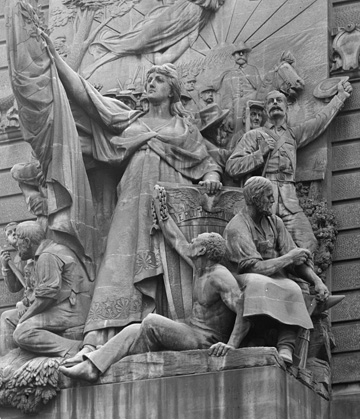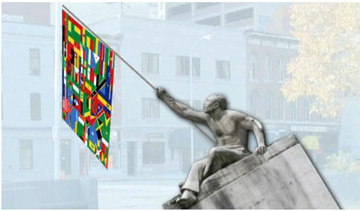“To make the monuments speak again we must question the often bland surface they show the world.” –Kirk Savage, Standing Soldiers, Kneeling Slaves
“Do I speak for everyone? No. No one speaks for everyone.” –Fred Wilson, Afternoons with Amos
Artist Fred Wilson looks at what institutions place on view and then uses his art to respond critically. His work challenges those institutions to reflect on their own practices and—sometimes—to change.
Wilson is famous for revealing how racism influences the art world, especially its practices of collection, exhibition, and interpretation. Recently, Wilson has shifted his attention beyond the art world to raise questions about how racism influences public space. In Indianapolis, a Wilson artwork is at the center of a heated debate about race and representation, power, and cultural politics.
The sculpture, called E Pluribus Unum, depicts a man of African heritage rising and reaching forward, his arm outstretched. His hand holds a flag representing the African diaspora. The Indianapolis Cultural Trail commissioned the work two years ago. One of seven original artworks created for the trail, Wilson’s figure was scheduled to be installed in September 2011 in commemoration of the Emancipation Proclamation.
Wilson’s figure is an appropriation of a sculpture lifted from the city’s iconic Indiana Soldiers and Sailors Monument. Erected in 1902 at the center of downtown Indianapolis to honor Civil War veterans, the monument is a 284-foot limestone shaft surrounded by fountains, plazas, and sculptural tableaux. E Pluribus Unum is 15-foot limestone replica made via 3-D digital scan. Wilson plans to site his figure a short distance from the monument at the city’s municipal complex. By extracting the man from the original monument, placing him upright, and siting him in a new public space, Wilson’s gesture takes a man who is invisible and anachronistic and makes him singular and contemporary.
According to art historian Kirk Savage, “Today public monuments are everywhere, so much a part of the landscape of our daily life that we hardly even notice them.” The allegorical and representational figures Rudolf Schwarz created to ornament the base of the Indiana Soldiers and Sailors Monument are certainly banal. Perhaps this is why, until the public announcement and release of artist renderings of E Pluribus Unum, no one seemed to notice that an image of a person emancipated from slavery occupied an important public space in Indianapolis.
- “I’ve been here all my life and not one time did I notice there was a free man on that monument.” –Sheila, a caller on Afternoons with Amos
Wilson himself noticed the figure through his work on The Spiral of History, an exhibition he created at the Indianapolis Museum of Art in 1993. During a recent local radio interview, program host Amos Brown related the story of the monument’s influence to Wilson and listeners: “You were walking around downtown and you went to a monument that I think virtually all of us in Indianapolis see but we don’t see. You saw something there that we overlooked. You said that it burned in your soul.” More than 15 years later, when Wilson was approached by curator Mindy Taylor Ross to create an artwork for the Indianapolis Cultural Trail, this image became his focus.

Rudolf Schwarz’s sculpture on the Indiana Soldiers and Sailors Monument provides the inspiration for "E Pluribus Unum." Photo from Library of Congress Prints and Photographs Division, Detroit Publishing Co. 017332.
Wilson noticed the figure among an array of sculptures comprising Schwarz’s tableau titled “Peace.” The shirtless, barefoot black man reaches up, broken chains dangling from his arm. As Wilson recalled for listeners to Amos in the Afternoons, “It was startling to me that this man was the only image of an African-American man on a major sculpture or monument in downtown.”
In an early project description, Wilson said, “I wanted to give this nameless man a purpose and his own place in Indianapolis.” Wilson told visual arts blogger Tyler Green, “I thought that by taking him out of context, he became a man and became something else other than just what was placed on him by the tropes of being in the monument.” Re-purposing the out-of-date image, Wilson hoped, would open a dialogue about contemporary issues related to representation and race.
In Indianapolis today, the dialogue is open and it is also difficult. Various Indianapolis institutions and individuals find the kinds of questions Wilson’s work raises uncomfortable, and the city’s political culture of “polite protest” complicates efforts to resolve conflicts over race and representation. A public forum held to discuss the project was so contentious, with an organized constituency of African-Americans speaking up about their concerns, that the Indianapolis Cultural Trail decided in November 2010 to place the project on hold indefinitely.
Undeterred, Wilson remains an engaged advocate for the work. He continues to make public presentations, meet with various African-American civic organizations and community leaders, and converse with concerned residents directly via talk radio. Throughout, he reinforces his intention “for the sculpture to be a catalyst for change.” Last month the project gained support when the Joyce Foundation awarded $50,000 toward its implementation. Clearly, Wilson understands the power of art to influence institutions.
In Mining the Museum, a 1992 exhibition at the Maryland Historical Society, Wilson culled and juxtaposed a mix of familiar and seldom-exhibited museum objects with commentary on exclusionary curatorial strategies. For example, he selected busts of Napoleon Bonaparte and Andrew Jackson to display alongside plaques bearing the names Harriet Tubman and Frederick Douglass. As Judith E. Stein wrote in her Art in America review of the exhibit, “Wilson found a canny way to reveal the slights of history and to indicate major gaps in the museum’s collections.” Wilson’s work invited viewers of the exhibition, including participants in the annual conference of the American Association of Museums held in Baltimore, to see the subtle and nefarious ways institutional racism expresses itself in the cultural sector.
A decade later at the 2003 Venice Biennale, Wilson created Speak of Me As I Am, calling attention to “blackamoors” — anachronistic black figures strangely present in Italian visual culture. Speaking about the figures to Phoebe Hoban of New York Magazine, Wilson said, “All of a sudden you see them everywhere. I wanted it to be visible, this whole world which sort of just blew up for me.”
“I’m interested in the invisible processes within museums,” Wilson told Art21 in 2005. Invisibility and public display are seemingly incompatible concepts, but Wilson’s practice reveals how curatorial choices and artistic gestures shape what we see. Wilson’s effort to draw attention to the influence of the invisible, the overlooked, and the taken-for-granted is important because of the questions he leads us to ask.




